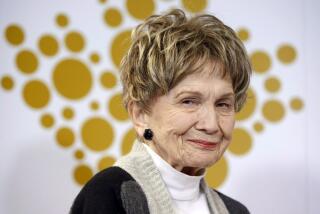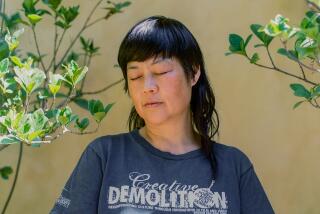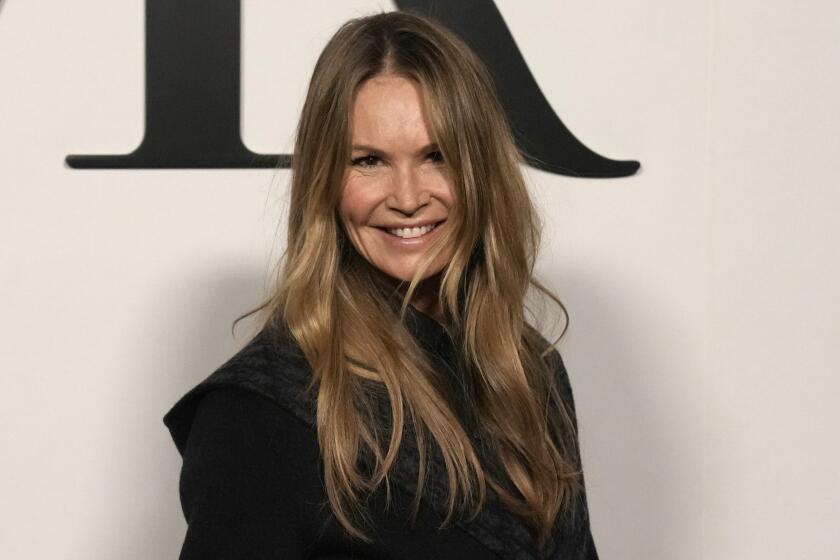Critic’s Notebook: Patti Smith’s ‘Woolgathering’
One thing I’ve always admired about Patti Smith is her refusal to be characterized. Rocker, poet, artist, mother: She seems to inhabit each of these roles almost effortlessly, moving among them as if the only difference was in our heads. And why not? For Smith, they all come out of the same impulse, a kind of ecstatic self-engagement, in which the line separating life and creativity, the mundane and the mystical, is an illusion, a border we create to bound ourselves. “Oh, God, I fell for you,” she sings at the end of her 1979 song “Dancing Barefoot,” and since the first time I ever played that record, I’ve heard this as a prayer, a benediction, as if it were God she had fallen for.
Such a sensibility — fluid, visionary, risky — marks the 11 pieces in “Woolgathering” (New Directions: 80 pp., $18.95), a collection of impressionistic prose poems that dances at the edge of memoir before opting for something harder to pin down. Originally published in 1992 as part of the series of small books (“3 by 4 inches in size,” Smith recalls, “like a tiny Indian prayer book that one could carry in one’s pocket”) released during the late 1980s and early 1990s by the delightfully idiosyncratic Hanuman Books, it has just been reissued, in a slightly expanded edition, and to read it again is to be reminded of just how interesting Smith can be. This is no sequel to the National Book Award-winning “Just Kids,” which traced her early years in New York with Robert Mapplethorpe. Rather, it is both wilder and more reflective, a portrait of Smith’s inner life, beginning in childhood and stretching into the undefined and ever-present now.
For Smith, it all starts with an invocation: “I always imagined I would write a book,” she declares in the opening line of the collection, “if only a small one, that would carry one away, into a realm that could not be measured nor even remembered.” That’s reminiscent of both her National Book Award acceptance speech (“When I was a clerk at Scribner’s bookstore,” she said, “I always dreamed of writing a book of my own”) and an echoing riff, at the end of “Woolgathering”: “So I leave myself to wonder and begin, for I always imagined I would one day write a book.”
Here, we see the circularity, not only of the pieces but also of Smith as an artist — the sense of purpose, of ambition even, mixed with her sense of the holiness of the task. “[T]here are precious words to grind,” she notes, as if literature were a physical practice, and throughout these pages, we get the impression of this work as, somehow, made by hand. “Relaxed, beneath the sky, contemplating this and that,” she writes in “Cowboy Truths,” dedicated to onetime boyfriend Sam Shepard. “The nature of labor. The nature of idleness and the sky itself with billowing masses so close one might lasso a cloud to pillow one’s head or fill one’s belly. Sopping up the beans and gravy with a chunk of cloud meat and lying back for a little siesta. What a life!”
Beans and gravy with a chunk of cloud meat? There it is, that mix of the practical and the mythic, like the marriage of rock ‘n’ roll and poetry. Such juxtapositions emerge repeatedly in “Woolgathering,” which begins with Smith’s childhood (“All my socks were out of shape,” she tells us. “Possibly because I often filled them with marbles. I’d load them with aggies and steelies and head out. It was the one thing I was good at and I could beat anyone around.”) before shifting into more metaphysical territory, a territory that is hers alone.
“On clear, peculiar nights,” she writes in “The Woolgatherers,” describing a field outside her bedroom window, “I sometimes saw movement in the grasses. At first I thought it to be the swipe of the white owl or the great pale winds of a luna moth spreading and unfolding like a medieval habit. But it came to me one night that they were people like none I had ever seen, in strange archaic cap and dress. I used to think I could see the white of their bonnets and, at times, a hand, in the act of grasping, illuminated by the moon and stars or the light from a passing car.”
There’s so much here that it’s worth our while to slow down and look more closely: the balance (again) of the visionary and the commonplace, the interplay of those ghostly figures with the physicality of a passing car. There’s the language, so precise, so imagistic, the wings of a moth “unfolding like a medieval habit,” the phrase “strange archaic cap and dress,” itself archaic and strange. There’s the sense of things happening beneath the surface, the notion of the world as, at heart, a place of mystery. And perhaps most important, there is Smith’s identification with these shades, these phantoms, who, she later learns, are called the woolgatherers — which becomes the way she frames herself also, as she “[wanders] among them, through thistle and thorn, with no task more exceptional than to rescue a fleeting thought, as a tuft of wool, from the combo of the wind.”
In that sense, it’s only fitting that “Woolgathering” should have emerged from the extended period of nearly total silence (1980-96) during which Smith lived in Michigan and raised two kids. What are parents if not woolgatherers? For Smith, however, writing the book served another purpose, offering a way out of what she calls “a terrible and inexpressible melancholy,” in which she “would sit for hours, when my chores were done and the children at school, beneath the willows, lost in thought.” It’s hard to read those lines without thinking of Mapplethorpe, who had died a couple of years before. But even more, I think, “Woolgathering” is the expression of an artist sitting in the exact center of her life (she finished the book on her 45th birthday) and considering where she’s been and where she wants to go.
Nearly 20 years later, this is no longer how we think of Smith; her public persona, such as it is, has been transformed by “Just Kids.” In its wake, she’s been remade as a post-punk rock den mother, a voice of remembrance for the bohemian life. And yet, in “Woolgathering,” we see her in the act of becoming, of imagining who she might still be. “[T]hese words of advice,” she writes, “[were] imparted with such a lightness that I was lifted and left to glide above the grass, although it appeared to all that I was still among them, wrapped in human tasks, with both feet on the ground.”
More to Read
Sign up for our Book Club newsletter
Get the latest news, events and more from the Los Angeles Times Book Club, and help us get L.A. reading and talking.
You may occasionally receive promotional content from the Los Angeles Times.








